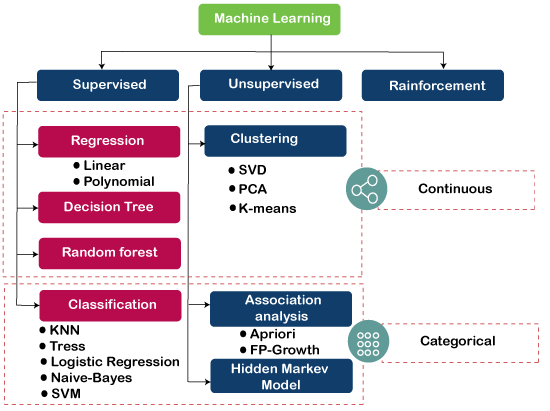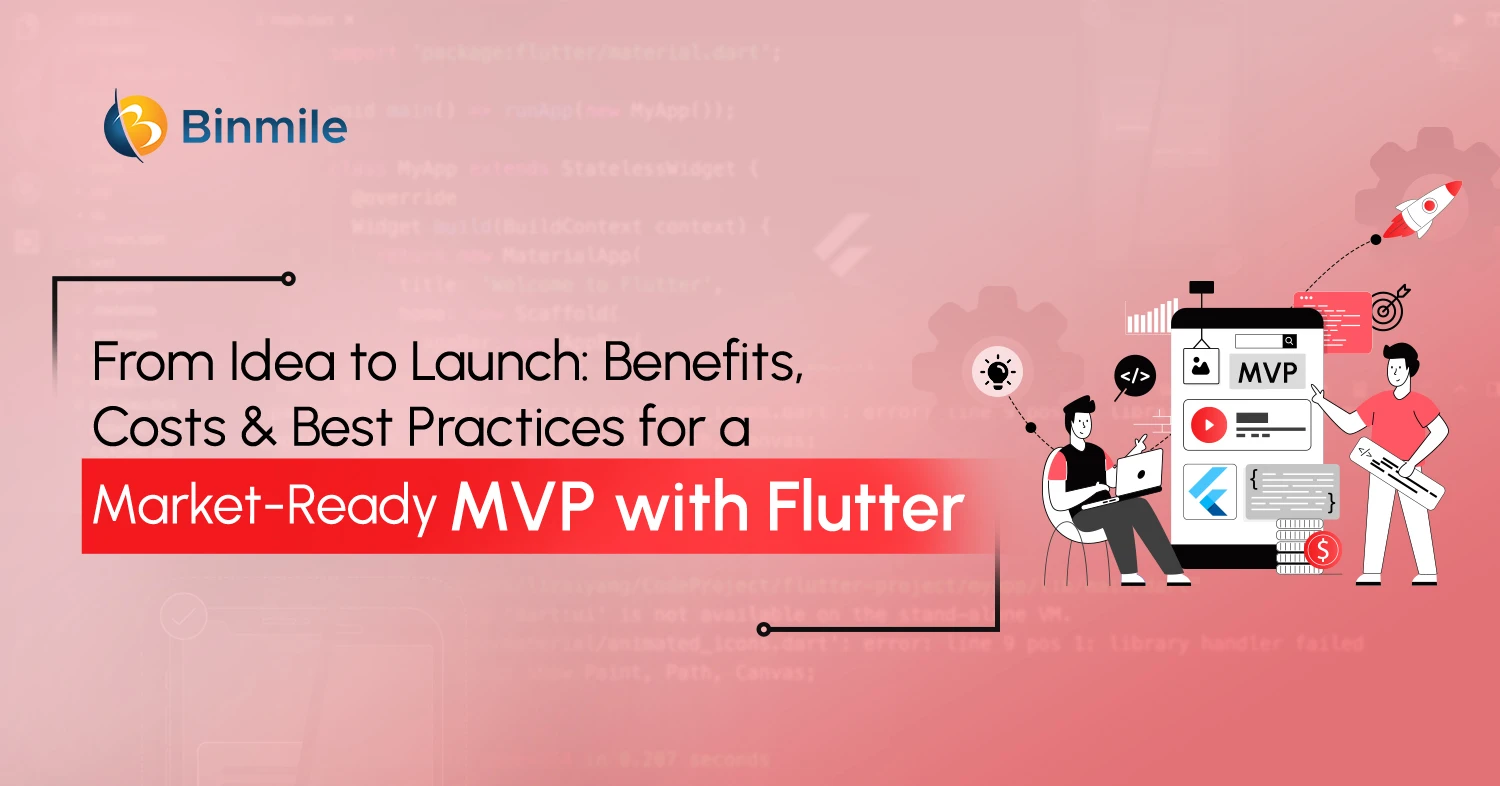Machine learning apps today signify business-transforming benefits for organizations worldwide. If you are familiar with artificial intelligence, you know that machine learning is one of the most important subfields of it. It is a set of tools and technologies to, ensure that computers can learn and adapt without human intervention. Interestingly, AI learns from machine learning algorithms (i.e., supervised, unsupervised, etc.) without being explicitly programmed or directly instructed. The goal is to carry out the desired action.
To some extent, we can say that most of what see today in the field of AI is the handiwork of machine learning. IT learns underlying patterns from a huge dataset without predefined programmed instruction. On close observation of the functions of both AI and ML, we come to know that they are deeply interconnected. They help companies in almost every industry today to transform their business process and products. Therefore, machine learning app development is one of the most desired services. They feature some broader industry-specific application areas, such as fitness apps, healthcare apps, eCommerce, and so on.
Why do Machine Learning Apps Matter?
Businesses in virtually every industry today can’t afford their anonymity in the competition. They can’t ignore the emerging new trends in technology. Mostly, companies can’t avert the rapid adoption of AI and ML in various industry-specific areas, like healthcare, finance, etc. Most importantly, organizations of any distinctive business size today can’t afford the oversight of downplaying innovative technologies, like ML. They see and appreciate these disruptive technologies. And companies that don’t could embrace the fallout of getting out of business, sooner or later.
So, choosing to get a machine learning app built is one of the most vital business necessities for companies. It is an approach conducive to gaining a competitive edge in today’s tough marketing landscapes. Hence, believe it or not, you CAN’T afford to see your brand fading out when its competitors thrive on the very adoption of ML-powered apps.
Benefits of Machine Learning Apps for Businesses in Every Industry
#1 A Maestro In Predictive Insights
If you understand the inherent mechanisms of machine learning algorithms, you know that they are capable of processing amounts of data too huge beyond your imagination to fathom their limits. The capability of processing massive amounts of data qualifies ML to generate quantitative predictions that users can configure based on their preferences. The ability to process data is one of the most significant steps in the machine learning (ML) pipeline. It is essential to build and train ML models through various steps, like cleaning, filtering, and transforming the data to the suitability of ML modeling. As a result, such ability of ML pans out engineering an improved model performance and increased accuracy of the ML models. These upsides collectively ensure the full-fledged capability of machine learning to generate predictive insights that companies can use to identify data-related patterns to discover risks and opportunities.
#2 A Terrific Financial Assistant
ML-powered mobile apps are hardwired to process huge amounts of data to generate predictive analysis. It happens based on the gathered insights into your personal finances or transaction history. Customers can learn from such analysis reflecting their spending habits and how to manage their finances. Banks, on the other hand, can leverage the data-driven insights facilitated by ML apps to provide a more personalized, customer-centric banking experience. For example, Bank Of America built an ML app called Erica, a mobile voice assistant that is now helping more than 25 million mobile app customers with personalized banking.

Source: theappsolutions.com
#3 Intuitive Product Recommendations
How many times have you noticed your Netflix account recommending specific video content and wondered how it read your thoughts? No, Netflix didn’t read your thoughts. Its ML algorithms see you watching your favorite shows and then interpret the behavioral patterns associated with your binge-watching. Finally, it recommends programs based on the learned patterns of your behavior. That explains why it is the world’s streaming leader. And that’s not just the lone example of Netflix.
Every streaming platform today leverages the power of ML and AI app development to finetune its strategies aiming to increase viewership counts. It may sound like a confusing thing but that’s just the miniature version of what gigantic power machine learning holds. Coming to the point, AI/ML-powered apps benefit businesses in eCommerce, streaming websites, and fashion sectors with intuitive product recommendations for customers. These recommendations are based on learned behavioral patterns of customers on, for example, an eCommerce website, like the history of purchases, searching patterns, cart history, and so many other cues that ML can interpret to understand and predict the desired outcome, which in this case, is product recommendation.
#4 Machine Learning Apps – Transforming Healthcare With Healthy Data Insights
ML-powered apps are designed to process massive amounts of healthcare data of patients. In turn, clinicians and patient care providers can understand and predict the possibility of health conditions associated with patients. Healthy data insights facilitated through AI and machine learning make way for streamlined treatment to augment the likelihood of better patient care in the long run.
Moreover, machine learning comes in handy for fraud detection using ML in finance. A report by the Justice Department of the US says that healthcare fraud in the country costs around $100 billion a year. That’s huge! And serious enough to validate the relevance of using apps based on machine learning models in the early detection of fraudulent insurance claims to save the industry from major financial loss.
#5 Machine Learning Apps – Real-Time Sentiment Analysis

Apps powered by machine learning’s sentiment analysis capability can perform real-time analysis of the emotive patterns of the speaker or the writer, thus filtering out the actual thought and textual tone. Therefore, the ML-powered sentiment analysis apps could come in handy for application areas, such as:
Social media monitoring
To filter out the most honest opinions about a product or service, helping businesses engage with customers in real-time.
Customer support
To read emotion, and tone and understand customer requests, enabling businesses to automatically process customer support tickets. Also facilitates phone calls or prioritizes intuitive customer support.
Brand monitoring
Sentiment analysis tools help businesses avoid bad reviews getting snowballed online. Enables them to monitor the progress of their brand image and reputation over time.
Product analysis
Sentiment analysis helps businesses to discover the perceptions of target customers about their products.
Market research
The technology of ML-based sentiment analysis can help you know where you stand in terms of positive mentions of your brand among your competitors. Accordingly, you will set the tone of your brand messaging or prioritize strategies to build a positive brand persona.
What to Involve in Building Machine Learning Apps?
The thing with developing mobile apps is that the involvement of machine learning is an extension of an add-on feature. Machine learning is always there in a mobile app as one of the key features to read and understand data inputs, like images, texts, or audio, and generate insights. So, you can’t deny the presence of AI and ML in any mobile app today because they are indispensable.
However, building a mobile app based on core competencies and the power of machine learning is a considerably rigorous process. It involves creating ML models to output valuable data. In other words, when you are custom building a mobile app, you involve machine learning models in it to benefit users. Here is our breakdown of steps about how to build ML app. But before moving ahead with that part, let’s discuss in brief what machine learning is all about and its key components.
What is Machine Learning in Layman’s Terms?
Machine learning is a part of or subdomain of artificial intelligence. You can say both are interconnected. You can also say that most works we see today in the field of artificial intelligence are the handwork of machine learning. That means machine learning is a crucial part that helps AI learn data inputs and become trained without human intervention or being explicitly programmed.
So, the job of machine learning is to train or teach computers to learn and be more proficient at performing tasks on their own. If you think that machine learning learns patterns on its own, that’s not right. It uses programmed algorithms. The capability of such algorithms is that they are designed to receive and analyze input data. In turn, they learned to predict output values. These algorithms rely on a new data feed to be able to learn and optimize their operations for better performance, leading to building advanced ‘intelligence’ over time.
Also Read: Innovative Developments in Artificial Intelligence
Types of Machine Learning Algorithms

1. Supervised Learning
In supervised learning, the labeled dataset is used to train the machine, enabling it to predict results based on the training dataset. For example, images of cats and dogs given to a machine with labels enable the machine to learn the images based on attributes, like size, colors, etc. It then creates responses based on its experience with the learned patterns. Here, the machine responses define its learned ability as a result of the training dataset it initially used to get trained.
Types of Supervised Learning
- Classification – In classification, the output variable is categorical, like yes or no, male or female, true or false, etc. A machine is trained to identify spam mail by subjecting it to a lot of spam filters, like reviewing the mail’s content, and mail header, and then searching for possible false data.
- Regression – The use of regression comes into the picture when the output variable features real or continuous value. In this case, the ML program must understand the relationship between two or more variables. Moreover, regression is useful for prediction as it uses one independent variable and a series of different other variables.
2. Unsupervised Learning
Unsupervised learning doesn’t involve labeled data for machine learning or it is not supervised using training datasets. ML models self-learn to identify hidden patterns and insights from unlabeled data. It may sound like machine learning algorithms are their own when it comes to drawing conclusions based on the presented (unlabeled) dataset.
3. Semi-Supervised Learning
Though it is similar to the concept of supervised learning, it uses both labeled and unlabeled data. The training mechanism it follows involves using a large amount of unlabeled data and a small amount of labeled data. Semi-supervised learning appears as an efficient solution to drawbacks shown by both supervised and unsupervised learning models. For instance, ML specialists or data scientists have to execute hand-labeling of data in supervised learning. On the other hand, unsupervised learning has a limited spectrum of applications.
4. Reinforcement Learning
This machine learning algorithm focuses on regimented learning processes. It receives a set of actions, parameters, and end values. Simply put, the algo seeks to function based on feedback involving an agent taught to behave in an environment by performing the actions and seeing the results of the actions. The agent gets positive feedback based on its good actions. It gets negative feedback or a penalty for each bad action. The learning process involves automatically using the feedback by the agent based on its experiential insights, considering there is no labeled data involved here.
How to Build a Machine Learning App

Building a machine learning application is not a single process. It involves iterative processes consisting of a sequence of events. Follow these steps to build an ML app.
Step #01 – Formulate The Problem
The first step to follow in building a machine learning app is to decide what you want to predict, also known as the target answer or label. Defining a problem should be in alignment with your use case or business requirement. For example, suppose you want to build products but you rely your decision on the number of potential sales of each product. In this context, you may want to predict the number of sales, something you can sort out using machine learning. For instance, if your prediction relates to the number of products sold, then your target is numeric and you are trying to solve a regression problem. Be cautious not to overcomplicate the problem. Frame the solution, simple enough to satisfy your business requirements.
Step #02 – Assemble The Right Team Of Specialists
Building a machine learning application is quite a delicate and painstaking task. To ensure the accomplishment of the same without technical hitches, you would need a team of specialists experienced enough to build an ML app by dealing with data and creating ML models. Consider hiring a world-renowned application development company to get yourself a winning ML app.
Step #03 – Collect The Data
This is one of the most critical steps in building an ML application. You can either go for open data sources or fetch the data from a historical database. Once the data is collected, clean it from meaningless data inputs. Cleaning the data ensures the accuracy of ML algorithms and would further ensure correct predictions in the future. Data collection is also a delicate process. The quality of the data will finally determine the efficacy of your ML app. For example, to predict whether an email is spam, it is important to collect both forms of data, positive (non-spam emails) and negative (spam emails) so that the ML algorithms can learn the patterns to identify the distinction between both forms of data.
Step #04 – Analyze And Prepare Data
Analyzing data means identifying issues and gaining insights into the data you are using. As outlined before, the quality of data you collect and feed determines the predictive power of your ML model. In addition, you need to convert the data into a format that ML can understand. Create a data pipeline to consolidate data from different sources for analysis. Meanwhile, consider variable and target data summaries to figure out if the data meets your expectations, or are invalid data than you expect. Moreover, you should also understand the correlation between each variable and the target class. For example, variables with high correlation have higher predictive power, whereas variables with low correlation should be left out.
Step #05 – Feature Engineering
It is also one of the crucial steps in building a machine-learning app. That’s because some data doesn’t have specific values compatible with machine learning algorithms. In other words, missing values caused by factors including data flow interruptions and human errors cast a corresponding impact on the performance of machine learning models. Feature engineering ensures the creation of additional features that combine two or more data features/attributes in an arithmetic operation with more relevancy.
Step #06–Proceed With Model Training
Training the model means ensuring that machine learning algorithms can perform better in data analysis. Before starting the training, split data into two distinct categories, like training, and evaluation. Once the training is over, the machine learning algorithms will learn and understand the patterns better. You can go for different model training approaches and take control of its learning rate, number of passes, regularization, etc. Understand that the training data used by the ML system is used to train models to identify patterns. It uses the evaluation data to measure how much the trained model is capable of its predictive quality.
Step #07– Optimize Model Accuracy
In this step, you need to take a close analysis of the performance value of your ML algorithm. You can employ a variety of accuracy metrics, like over-fitting or under-fitting. Moreover, optimize the algorithms and training data based on the results you get to improve model accuracy.
Step #08 – Deploy Model In Production
This is the last step in the context of building a machine-learning app. Once the model training is over, deploy it in production, meaning integrate it into your application to make predictions based on the accurate data.
Concluding Statement
Machine learning is not a new tech phenomenon. If you are familiar with artificial intelligence, you may know that a lot of start-ups, SMEs, and enterprise-level businesses are building AI-powered apps. Considering the transformative impacts of machine learning on businesses, harnessing its power into building apps is the demand of the time for organizations. They can achieve better growth due to improved customer engagement and retention, among other benefits that ML apps could deliver.
However, the concept of building a machine learning app is not that easy to put into materialization. That’s because it is quite a delicate and painstaking process. You must be considerably experienced in technical know-how of how ML works, its types, and other components it features. Moreover, you must be familiar with how a project development lifecycle works. You would require setting up a team of specialists to carry out the task of building a machine-learning solution for your business.
To help you avoid the hassles of hiring a fresh development team or resource allocation of the existing workforce on the task of building an ML app, consider hiring Binmile’s software development services. World-renowned and innovative, we can help you with cutting-edge ML apps to solve your business woes, helping you gain spotlights in your niche.









